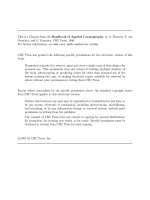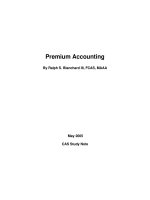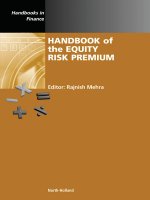chap13 premium THEORY OF PRODUCTION AND COST
Bạn đang xem bản rút gọn của tài liệu. Xem và tải ngay bản đầy đủ của tài liệu tại đây (1.46 MB, 47 trang )
UNIVERSITY OF FINANCE AND MARKETING
MICROECONOMICS
Chapter 4
THEORY OF
PRODUCTION
AND COST
Assoc. PhD.Trần Nguyễn Ngọc Anh Thư
MBA. Đoàn Ngọc Phúc
MBA. Phạm Thị Vân Anh
MBA. Lại Thị Tuyết Lan
MBA. Nguyễn Thị Quý
MBA. Ngô Thị Hồng Giang
MBA. Nguyễn Thị Hảo
HCM City - 2013
1
ACTIVE LEARNING
Brainstorming
1:
You run Truong Hai Oto Company.
List 3 different costs you have.
List 3 different
business decisions
that are affected
by your costs.
2
In this chapter, look for the answers to
these questions:
What is a production function? What is marginal
product? How are they related?
What are the various costs, and how are they
related to each other and to output?
How are costs different in the short run vs. the
long run?
What are “economies of scale”?
CHAPTER 13
THE COSTS OF PRODUCTION
3
Total Revenue, Total Cost, Profit
We assume that the firm’s goal is to maximize
profit.
Profit = Total revenue – Total cost
the amount a
firm receives
from the sale
of its output
CHAPTER 13
THE COSTS OF PRODUCTION
the market
value of the
inputs a firm
uses in
production
4
Costs: Explicit vs. Implicit
Explicit costs – require an outlay of money,
e.g. paying wages to workers
Implicit costs – do not require a cash outlay,
e.g. the opportunity cost of the owner’s time
Remember one of the Ten Principles:
The cost of something is
what you give up to get it.
This is true whether the costs are implicit or
explicit. Both matter for firms’ decisions.
CHAPTER 13
THE COSTS OF PRODUCTION
5
Explicit vs. Implicit Costs: An
Example
You need $100,000 to start your business.
The interest rate is 5%.
Case 1: borrow $100,000
• explicit cost = $5000 interest on loan
Case 2: use $40,000 of your savings,
borrow the other $60,000
• explicit cost = $3000 (5%) interest on the loan
• implicit cost = $2000 (5%) foregone interest you
could have earned on your $40,000.
In both cases, total (exp + imp) costs are $5000.
CHAPTER 13
THE COSTS OF PRODUCTION
6
Economic Profit vs. Accounting
Profit
Accounting profit
= total revenue minus total explicit costs
Economic profit
= total revenue minus total costs (including
explicit and implicit costs)
Accounting profit ignores implicit costs,
so it’s higher than economic profit.
CHAPTER 13
THE COSTS OF PRODUCTION
7
2:
Economic profit vs. accounting profit
ACTIVE LEARNING
The equilibrium rent on office space has just
increased by $500/month.
Compare the effects on accounting profit and
economic profit if
a. you rent your office space
b. you own your office space
8
ACTIVE LEARNING
Answers
2:
The rent on office space increases $500/month.
a. You rent your office space.
Explicit costs increase $500/month.
Accounting profit & economic profit each fall
$500/month.
b.You own your office space.
Explicit costs do not change,
so accounting profit does not change.
Implicit costs increase $500/month (opp. cost
of using your space instead of renting it),
so economic profit falls by $500/month.
9
The Production Function
A production function shows the relationship
between the quantity of inputs used to produce a
good, and the quantity of output of that good.
It can be represented by a table, equation, or
graph.
Example 1:
• Farmer Jack grows wheat.
• He has 5 acres of land.
• He can hire as many workers as he wants.
CHAPTER 13
THE COSTS OF PRODUCTION
10
Example 1: Farmer Jack’s Production
Function
Q
(no. of (bushels
workers) of wheat)
3,000
Quantity of output
L
2,500
0
0
1
1000
2
1800
3
2400
500
4
2800
0
5
2,000
1,500
1,000
3000
CHAPTER 13
THE COSTS OF PRODUCTION
0
1
2
3
4
5
No. of workers
11
Marginal Product
The marginal product of any input is the
increase in output arising from an additional unit
of that input, holding all other inputs constant.
E.g., if Farmer Jack hires one more worker,
his output rises by the marginal product of labor.
Notation:
∆ (delta) = “change in…”
Examples:
∆Q = change in output, ∆L = change in labor
∆Q
Marginal product of labor (MPL) =
∆L
CHAPTER 13
THE COSTS OF PRODUCTION
12
EXAMPLE 1: Total & Marginal
Product
L
Q
(no. of (bushels
workers) of wheat)
∆L = 1
∆L = 1
∆L = 1
∆L = 1
∆L = 1
CHAPTER 13
0
0
1
1000
2
1800
3
2400
4
2800
5
3000
MPL
∆Q = 1000
1000
∆Q = 800
800
∆Q = 600
600
∆Q = 400
400
∆Q = 200
200
THE COSTS OF PRODUCTION
13
EXAMPLE 1: MPL = Slope of Prod Function
Q
(no. of (bushels MPL
workers) of wheat)
0
1
2
3
4
5
0
1000
1800
2400
2800
3000
CHAPTER 13
1000
800
600
400
200
MPL
3,000
Quantity of output
L
equals the
slope of the
2,500
production function.
2,000
Notice that
MPL diminishes
1,500
as L increases.
1,000
This explains why
500 production
the
function
gets flatter
0
as L0increases.
1
2
3
THE COSTS OF PRODUCTION
4
5
No. of workers
14
Why MPL Is Important
Recall one of the Ten Principles:
Rational people think at the margin.
When Farmer Jack hires an extra worker,
• his costs rise by the wage he pays the worker
• his output rises by MPL
Comparing them helps Jack decide whether he
would benefit from hiring the worker.
CHAPTER 13
THE COSTS OF PRODUCTION
15
Why MPL Diminishes
Diminishing marginal product:
the marginal product of an input declines as the
quantity of the input increases (other things equal)
E.g., Farmer Jack’s output rises by a smaller and
smaller amount for each additional worker. Why?
If Jack increases workers but not land,
the average worker has less land to work with,
so will be less productive.
In general, MPL diminishes as L rises
whether the fixed input is land or capital
(equipment, machines, etc.).
CHAPTER 13
THE COSTS OF PRODUCTION
16
EXAMPLE 1: Farmer Jack’s Costs
Farmer Jack must pay $1000 per month for the
land, regardless of how much wheat he grows.
The market wage for a farm worker is $2000 per
month.
So Farmer Jack’s costs are related to how much
wheat he produces….
CHAPTER 13
THE COSTS OF PRODUCTION
17
EXAMPLE 1: Farmer Jack’s Costs
L
Q
(no. of (bushels
workers) of wheat)
cost of
land
cost of
labor
Total
Cost
0
0
$1,000
$0
$1,000
1
1000
$1,000
$2,000
$3,000
2
1800
$1,000
$4,000
$5,000
3
2400
$1,000
$6,000
$7,000
4
2800
$1,000
$8,000
$9,000
5
3000
$1,000 $10,000
$11,000
CHAPTER 13
THE COSTS OF PRODUCTION
18
EXAMPLE 1: Farmer Jack’s Total Cost
Curve
Q
(bushels
of wheat)
Total
Cost
0
$1,000
1000
$3,000
1800
$5,000
2400
$7,000
2800
$9,000
3000
$11,000
CHAPTER 13
THE COSTS OF PRODUCTION
19
Marginal Cost
Marginal Cost (MC)
is the increase in Total Cost from
producing one more unit:
∆TC
MC =
∆Q
CHAPTER 13
THE COSTS OF PRODUCTION
20
EXAMPLE 1: Total and Marginal Cost
Q
(bushels
of wheat)
∆Q = 1000
∆Q = 800
∆Q = 600
∆Q = 400
∆Q = 200
CHAPTER 13
Total
Cost
0
$1,000
1000
$3,000
1800
$5,000
2400
$7,000
2800
$9,000
3000 $11,000
Marginal
Cost (MC)
∆TC = $2000
$2.00
∆TC = $2000
$2.50
∆TC = $2000
$3.33
∆TC = $2000
$5.00
∆TC = $2000
$10.00
THE COSTS OF PRODUCTION
21
EXAMPLE 1: The Marginal Cost Curve
Q
(bushels
of wheat)
0
TC
MC
$1,000
1000
$3,000
1800
$5,000
2400
$7,000
2800
$9,000
3000 $11,000
CHAPTER 13
MC usually rises
as Q rises,
as in this example.
$2.00
$2.50
$3.33
$5.00
$10.00
THE COSTS OF PRODUCTION
22
Why MC Is Important
Farmer Jack is rational and wants to maximize
his profit. To increase profit, should he produce
more wheat, or less?
To find the answer, Farmer Jack
needs to “think at the margin.”
If the cost of additional wheat (MC) is less than
the revenue he would get from selling it,
then Jack’s profits rise if he produces more.
(In the next chapter, we will learn more about
how firms choose Q to maximize their profits.)
CHAPTER 13
THE COSTS OF PRODUCTION
23
Fixed and Variable Costs
Fixed costs (FC) – do not vary with the quantity
of output produced.
• For Farmer Jack, FC = $1000 for his land
• Other examples:
cost of equipment, loan payments, rent
Variable costs (VC) – vary with the quantity
produced.
• For Farmer Jack, VC = wages he pays workers
• Other example: cost of materials
Total cost (TC) = FC + VC
CHAPTER 13
THE COSTS OF PRODUCTION
24
EXAMPLE 2
Our second example is more general,
applies to any type of firm,
producing any good with any types of inputs.
CHAPTER 13
THE COSTS OF PRODUCTION
25









